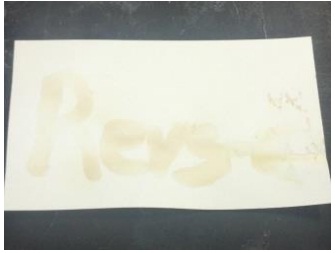





Published on Apr 02, 2024
Our vision is often described as a molecular switch. The word switch probably makes you think of a light switch. In our eyes, the switch is much smaller than a light switch, however, there is a reaction in our eyes that works as a switch to turn “on” and “off” our vision. To begin this explanation, we will talk about the source of this switch, a molecule called retinal which is in all of our eyes. The retinal molecule responds to light. As the light hits our eyes, retinal “switches on” our vision. When we close our eyes or are in a very dark room with no light at all, we are no longer able to see. However, the objects in the room are still there even though we cannot see them. We will simulate this by using invisible ink. Invisible ink cannot be seen by our eyes until we add a special ingredient to make it visible.
Invisible inks are used to send secret messages. Secret messages are hidden within an ordinary letter, and can be revealed by the receiver. A secret message prevents other people from reading the message, or even knowing it is there. A secret message should be used with a believable normal message in order to hide the secret message (a blank piece of paper would be suspicious!). Invisible inks can be used as a fun way to communicate secretly with friends. An ideal invisible ink should be easily made, hard to detect and easily and safely revealed. Invisible inks are normally non-greasy and not visible under ultra violet light (a common screening method for post). Commonly acids and bases are used as invisible inks, and these are revealed by indicators.
Indicators are chemical compounds which are different colours when in contact with either acids or bases. With acids, indicators generally turn red, and with bases they generally turn a blue/green colour. In addition to indicators, heat can also be used to reveal messages. A substance applied to the paper that burns at a lower temperature than the paper and so the message is revealed. In this practical you will investigate making up solutions and then using them to create your own secret messages!
• Baking Soda
• Paper
• Water
• Light Bulb (heat source)
• Paintbrush or Swab
• Measuring Cup
• Purple Grape Juice
• Paper
• Small Sponge

1. There are at least two methods to use baking soda as an invisible ink. Mix equal parts water and baking soda.
2. Use a cotton swab, toothpick, or paintbrush to write a message onto white paper, using the baking soda solution as 'ink'.
3. Allow the ink to dry.
4. One way to read the message is to hold the paper up to a heat source, such as a light bulb. The baking soda will cause the writing in the paper to turn brown.
5. A second method to read the message is to paint over the paper with purple grape juice. The message will appear in a different color.
1. If you are using the heating method, avoid igniting the paper - don't use a halogen bulb.
2. Baking soda and grape juice react with each other in an acid-base reaction, producing a color change in the paper.
3. The baking soda mixture can also be used more diluted, with one part baking soda to two parts water.
4. Grape juice concentrate results in a more visible color change than regular grape juice.
1. Mix a small amount of water with cornstarch (use about 2 tablespoons of cornstarch and 4 teaspoons of water) in the pan and stir until smooth.
2. Heat the mixture for several minutes. Stir. (heat each mixture separately)
3. Dip a toothpick into the cornstarch and water mixture and write with the mixture on paper. Let the paper dry.
4. To observe the message, dip the small sponge into the iodine solution and carefully wipe the paper. Do not get the paper too wet. The message should appear purple.
An acid-base indicator is a weak acid or a weak base. The undissociated form of the indicator is a different color than the iogenic form of the indicator. An Indicator does not change color from pure acid to pure alkaline at specific hydrogen ion concentration, but rather, color change occurs over a range of hydrogen ion concentrations. This range is termed the color change interval. It is expressed as a pH range.
Weak acids are titrated in the presence of indicators which change under slightly alkaline conditions. Weak bases should be titrated in the presence of indicators which change under slightly acidic conditions.
Several acid-base indicators are listed below, some more than once if they can be used over multiple pH ranges. Quantity of indicator in aqueous (aq.) or alcohol (alc.) solution is specified. Tried-and-true indicators include: thymol blue, tropeolin OO, methyl yellow, methyl orange, bromphenol blue, bromcresol green, methyl red, bromthymol blue, phenol red, neutral red, phenolphthalein, thymolphthalein, alizarin yellow, tropeolin O, nitramine, and trinitrobenzoic acid. Data in this table are for sodium salts of thymol blue, bromphenol blue, tetrabromphenol blue, bromcresol green, methyl red, bromthymol blue, phenol red, and cresol red.
1. Sciencekids.com http://www.sciencekids.co.nz/experiments/invisibleink.html
2. Foster, K., Ghering, C., Light, M. and McCollum, M. (1999). Secret methods and techniques – invisible ink. Retrieved 20 November, 2009 from, http://www.si.umich.edu/spies/methods-ink.html
3. Narasimhan, B. R. V., Prabhakar, S., Manohar, P. and Gnanam, F. D. (2001). Synthesis of gamma ferric oxide by direct thermal decomposition of ferrous carbonate. Retrieved 20 November, 2009 from, http://www.sciencedirect.com/science